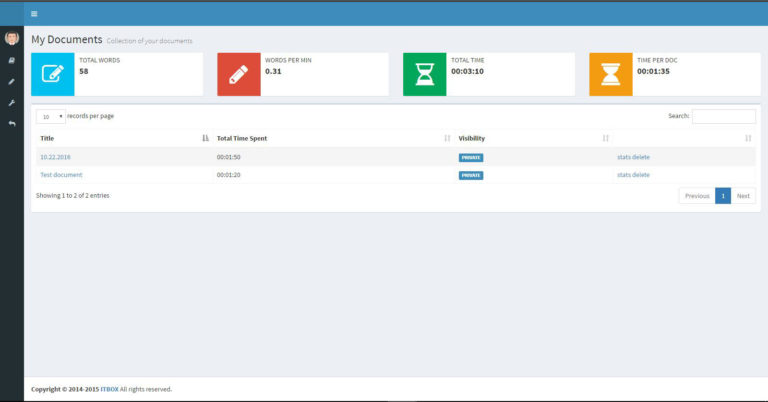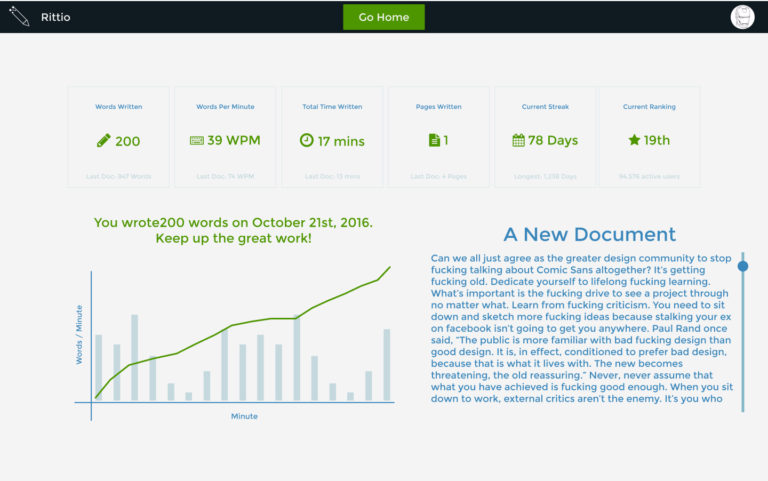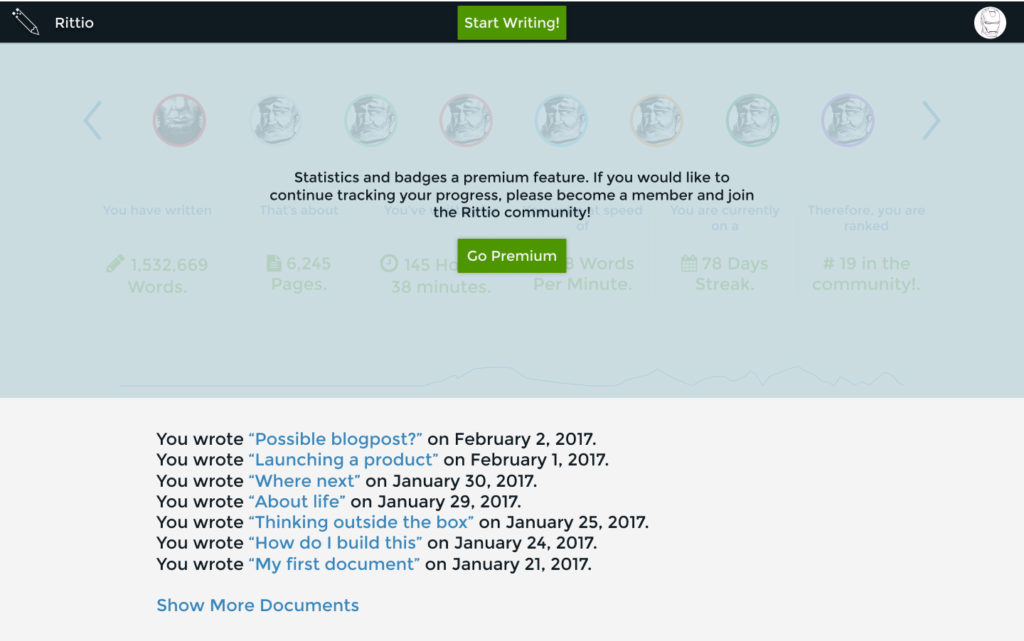Helping users build a writing habit.
Details:
Category:Product, Branding
Client:Founder
Time:Dec 2016 - Present
I've always been a passionate writer and storyteller. My preferred mediums are screenwriting and keeping a journal. While writing has become easier than ever thanks to smartphones and PCs, it still scares people. Common sentiments include “I’m a terrible writer,” "I don't have anything to write about!," or “It’s a waste of time in my industry.” I designed and built Rittio to solve this by empowering users to build a daily writing habit. Rittio focuses on helping users track growth, providing a simple and fun user experience for daily writing, and maintaining a completely secure writing environment. From initial concept to designing the launch-ready product, I was responsible for every step of this project. I collaborated with Alexey and his team at Dev-Better to bring life to Rittio, and launched it in February 2017. I continue to support, improve, and grow the product!
Creating Rittio
Gathering Information
Before creating a single screen, I spent July 2015 - January 2016 testing other available platforms. The daily journaling space is not crowded, but does have some incumbent players. I interviewed 50+ potential users to across multiple demographics to better understand what shortcomings they saw in the space, and to define a wish-list of desired features. In January 2016, I commissioned the creation of a low cost (<300 USD) prototype which I dubbed CoolPen. Coolpen was built by a freelance dev named Ivan using Java, and was a simple way to play with the features I had seen in other platforms. Other than providing a basic written overview of the concept, I let Ivan make all design and development decisions.

Laying Out The Plan
Based on user reactions to CoolPen, as well as my initial research, I decided that Rittio would be most applicable to the 18 to 35 year old demographic. These users tend to invest in personal growth and see the value in building skills, even if those skills are tangential to their direct line of study and/or profession. Additionally, I found most of the platforms were targeting writers in the 35 to 55 age range, and had UIs and UXs designed for these individuals. I found that potential users across all personas were most concerned with privacy and security. In addition, this group tended to value clean and simple design as opposed to feature overload.

Creating the Rittio Identity
I wanted the brand to reflect a modern yet simple image, while retaining a visual minimal aesthetic. I wanted a simple color palette which didn't distract users from the platform's primary purpose: writing. The use of muted primary colors and simple geometries helped me convey a sense of modern calm to my users. While I was partial to an iteration which had lines running through the middle of the pen shape, market testing showed that users preferred a version without those flourishes.

Building The Platform
Armed with a thorough understanding of the competitive landscape, user needs, and a firm set of design guideposts for this product, I started creating screens for version 1.0 of Rittio. The primary screens were the Home screen, the Composer screen, and the View Statistics screen. I wanted users to spend more than 80% of their time on the Composer screen -- therefore, I made the primary call to 'Start Writing!' I emphasized this action by contrasting its colors against the toolbar. The button is also persistent on every screen within the application.
Statistics and Badges were also given a high priority, both in terms of positioning and emphasis. Statistics were simple, and presented the most relevant information to users in a bold and easy to understand format. Hovering over any of the stats gives users more insights into that particular category of statistics.
The badges were designed by a very talented Thai artist named Rubina who was recommended by a mutual friend. I loved her simple yet playful artistic style, and she seemed to get the style and aesthetic of the product. Her work was top notch, and the badges she created are a phenomenal motivation for users!
The overwhelming majority of potential users reported using a desktop or laptop computer for most of their writing. Therefore, the initial focus of Rittio was on the browser-based desktop experience. However, in order to promote user retention and give users the ability to write and access writing on the go (especially in case they needed to maintain their streak), the desktop experience had to be adapted for mobile platforms as well. The biggest usability challenge on mobile was simplifying the statistics so that users could still access them without being overwhelmed.
Launching Rittio
Rittio launched in February 2017 and the initial feedback was overwhelmingly positive; users praised the simple minimalist style of the platform, found statistics and badges to be a great motivator to continue using the platform, and enjoyed the overall user experience. The major criticism was with the table-style presentation of past documents. Personally, I hate tables as they are clunky and over-power a screen. I included this feature because in my design research, users emphasized the ability to be able to go back and sort/find past writing. However, I should have drilled deeper into that requirement, as it is now clear that the only criteria users wanted to sort by was date written.
Final Thoughts
I have already started planning for version 2.0 (preview shown below). The major change would replace the table with a chronologically sorted list of past writing. Additionally, I intend to implement monetization which would give users access to the full platform for 30 days, after which they can choose to keep Statistics and Badges by paying 5 USD per month. However, writing on the platform will always be free for everyone, forever!
I was very pleased with the simplicity of the launch version. Current active users (as of April 2017) seem to log into the platform daily, and write an average of 200 words a day. I sincerely hope that Rittio helps people build and maintain a strong writing habit, and I look forward to continuing to grow the user base!





